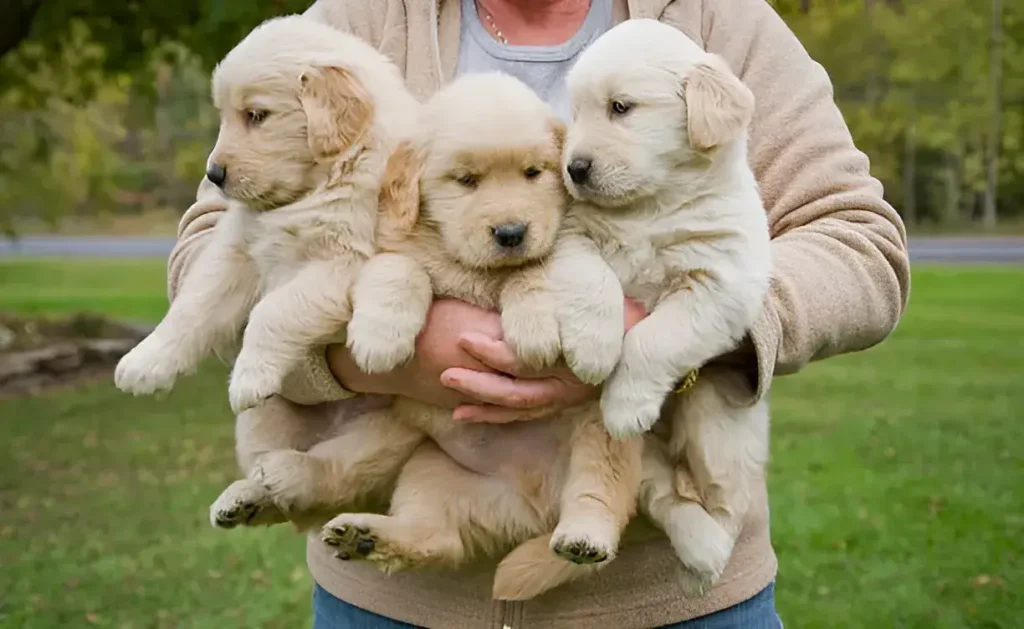The average dog litter has 5-6 puppies, but the actual number can vary wildly, ranging from 1 to 12 puppies or more! Several factors influence litter size, the most significant being the dog’s breed. Let’s explore what determines a dog’s litter size and provide tips for those expecting a furry family.
Breed: The Primary Influence
Dogs, as diverse as they are, exhibit vast differences in size and shape across breeds. Naturally, this has a direct impact on litter size:
- Giants of the Canine World: Mastiffs, Great Danes, and other colossal breeds often deliver litters with ten or more pups.
- Middle-Ground Breeds: Retrievers, shepherds, and similarly sized dogs tend to have litters ranging between five and eight puppies.
- Smaller Companions: Yorkies, Chihuahuas, and toy breeds generally have the smallest litters, averaging around two to four puppies.
Beyond Breed: What Else Affects Litter Size
- Age: A female dog’s first litter is often smaller than subsequent ones. As she ages, litter size may peak and then gradually decrease.
- Health: Healthy, well-nourished dogs tend to have larger litters. Any underlying health conditions can affect litter size.
- Hormones The number of eggs a female releases during ovulation plays a key role in the number of puppies.
Can You Predict Litter Size?

While getting an exact number is difficult, there are helpful ways to estimate:
- Veterinary Exam: Your vet can feel your expectant dog’s abdomen and potentially offer a rough estimate.
- X-rays and Ultrasounds: These provide a more accurate idea of litter size, especially in the later stages of pregnancy.
Preparing for the Pups
Knowing your dog could deliver a range of pups makes preparation essential. Have the following ready:
- Whelping Box: A safe, enclosed space for birth and puppy care.
- Puppy Supplies: Bottles, formula (if needed), warming pads, soft bedding, etc.
- Veterinarian Contact: Have your vet’s number and emergency clinic info on hand in case of complications.
Beyond the Averages
- Record Breakers: Some large breeds have had litters of 20+ puppies! These present unique challenges for both mother and pups.
- Single Pups: Occasionally, there’s only one puppy. These “singletons” may need extra attention for warmth and socialization.
Responsible Breeding: A Note

Bringing puppies into the world is a big responsibility. If you’re considering breeding:
- Health Testing: Ensure parents are free from genetic conditions.
- Home Preparation: Are you ready for the commitment and have suitable homes lined up for the puppies?
- Ethical Focus: Prioritize the well-being of the mother dog and the puppies above all else.
Spaying and Neutering: A Responsible Choice
Aside from preventing unwanted litters, spaying (for females) and neutering (for males) are crucial aspects of responsible pet ownership. These procedures offer several benefits:
- Pet Population Control: Reducing overpopulation eases the burden on shelters and rescues.
- Health Advantages: Spayed and neutered dogs often have longer lifespans and a lower risk of certain cancers and behavioral problems.
- Finding Affordable Services: Many organizations provide resources and support to help find low-cost or free spay/neuter options.
Understanding the Risks of Large Litters
While a big bundle of puppies is a heartwarming sight, it’s important to understand the potential challenges involved. Large litters can:
- Strain on the Mother: Increase the risk of birthing complications and make providing adequate care for all the pups difficult.
- Challenges for Puppies: Puppies may face competition for nutrition and have a higher risk of health issues in large litters.
- Importance of Veterinary Care: Close monitoring by a vet is essential for the well-being of both the mother and the pups in the case of large litters.
Supporting Your Pregnant Dog

Caring for your pregnant dog is essential for a healthy mama and thriving puppies. Here’s how to support her through the roughly 63-day pregnancy:
Nutrition (Fueling Mom and Pups): During pregnancy, switch your dog to a high-quality food formulated specifically to support pregnant or nursing mothers. These diets contain the extra calories, protein, and essential nutrients she needs to nourish herself and her growing puppies.
Gentle Exercise: Regular walks or playtime are still important, but avoid overly strenuous activities. Let her set the pace.
Cozy Den: Prepare a whelping box in a quiet, warm space. Line it with soft blankets to create a welcoming environment for birth and the first weeks with her pups.
Veterinary Care (Your Pregnancy Partner): Regular visits to your veterinarian are essential throughout your dog’s pregnancy. Your vet will monitor the health of both mom and puppies, discuss any potential concerns, and help you prepare for a smooth birth experience.
Myths and Misconceptions about Litter Size
Don’t fall prey to these common myths about canine litters:
- Myth: The size of the first litter predicts future litters. Fact: While a dog’s first litter may be smaller, subsequent litter sizes can vary.
- Myth: You can breed for specific colors or traits to guarantee certain outcomes. Fact: Puppy genetics are complex, and outcomes aren’t always predictable.
Always base your breeding decisions on sound science and health considerations.
Preparing for the Birth
As the due date approaches, watch for signs of impending labor like restlessness, nesting behaviors, and changes in body temperature. A normal birth usually proceeds without issues, but be prepared to contact your veterinarian in case complications arise.
Fascinating Facts About Dog Litter Sizes
- Did you know the smallest dog breed, the Chihuahua, often has litters proportionally larger than their body size?
- It’s rare, but possible for a single litter of puppies to have multiple fathers!
- The Guinness World Record for largest dog litter belongs to a Neapolitan Mastiff who delivered a remarkable 24 puppies in 2004.
Conclusion
Dog litters are a wonderful example of the amazing diversity in the canine world. While averages exist, each pregnancy is a unique journey. By understanding the factors that impact litter size and providing appropriate care, you can help ensure a positive and fulfilling experience for both the mother dog and her adorable puppies.
The photo featured below the post headline is Credit: Catherine Falls Commercial/gettyimages
I hope you find this post helpful and informative. If Yes’ feel free to share it with your friends!
Frequently Asked Question
How often can a dog have litters?
Most responsible breeders allow a female dog to have only a few litters over her lifetime, with sufficient rest in between to ensure her health.
Do all puppies in a litter survive?
Sadly, not always. It’s important to closely monitor newborn puppies for any signs of health issues.
Can I influence the size of my dog’s litter?
Not directly. Ensuring your dog is healthy and working with a responsible veterinarian is the best way to support a successful pregnancy.
How many puppies are usually in a first litter?
A dog’s first litter is often smaller than subsequent ones, averaging around 3-5 puppies. However, this can vary greatly depending on breed and individual factors.
Which dog breed has the largest litter?
Large and giant breeds generally have the largest litters. Breeds like Mastiffs, Great Danes, and Newfoundlands can have 10-15 puppies or more in a single litter.
What’s the smallest number of puppies considered a litter?
While we often picture litters with many puppies, even a single puppy is technically considered a litter. Smaller litters of 2-3 puppies are especially common among toy breeds.
Which dog breed typically has the most puppies in a litter?
The Neapolitan Mastiff holds the record for the largest dog litter, with 24 puppies born in 2004.
How many puppies can a dog have in a year?
Technically, a healthy female dog could have 2-3 litters per year. However, responsible breeding practices prioritize the dog’s health, so back-to-back litters are strongly discouraged.
Is a dog’s second litter usually larger?
Yes, a dog’s second litter is often slightly larger than her first. Litter size can peak for a few cycles before gradually decreasing as the dog ages.
Can puppies in a litter have different fathers?
Yes, surprisingly, it’s possible! If a female dog mates with multiple males within a short timeframe, a single litter could have puppies with different fathers.
Do all the puppies in a litter look the same?
Not necessarily! Even within purebred litters, puppies can inherit different combinations of genes, resulting in variations in coat color, markings, and even slight differences in build.

